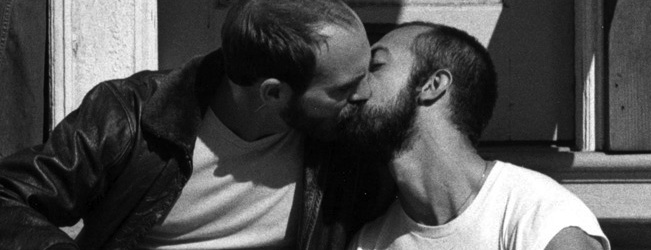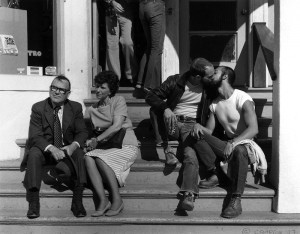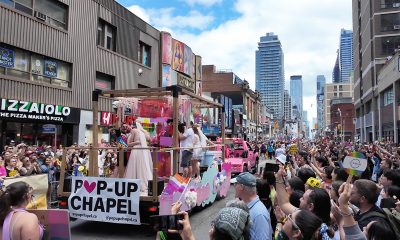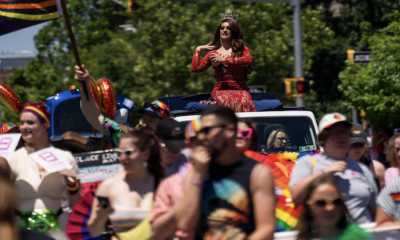Living
Castro catastrophe
‘We Were Here’ offers first-hand accounts of AIDS horrors in San Francisco


A vintage still from San Francisco's Castro neighborhood used in 'We Were Here.' (Photo courtesy of Film Collaborative)
There were angels in San Francisco.
But unlike in Tony Kushner’s two-part Pulitzer-Prize-winning play about AIDS — “Angels in America,” set in New York City in the mid-1980s — these angels were real people.
In the Kushner play, an angel descends to earth, as his fictional characters struggled with this unsettling new disease, the “gay cancer” as it was being called, an epidemic that seemed to spring from nowhere and then spread like a wicked wildfire.
In San Francisco it also struck like a bolt from the blue and purple unknown, its stigmata the purple-ish and dark reddish-blue marks of skin lesions — those herpes-like, cancerous tumors of Kaposi’s sarcoma — that began to dot faces and limbs and torsos with an ugliness that was unmistakable and the cause unknown. Right-wing televangelist Jerry Falwell called the lesions, which were seen as the defining illnesses of AIDS in the 1980s, to be the signs of Satan’s claim over sins of the flesh and God’s punishment for those same-sex sins, demons of a heaven-sent plague upon homosexuality.
“For a group of gay men, so into physical appearance, this was a disease whose very physical manifestations were horrifying,” says Daniel, one of the five people profiled in a new and deeply affecting documentary film, “We Were Here,” a gut-punch of a feature-length film by producer-director David Weissman, about the coming of AIDS to the Bay Area, and the human havoc it wrought.
This film is truly a moving picture. Co-presented with Reel Affirmations, as part of the 25th Annual FilmFest D.C. (now through April 17), it is playing tonight and Saturday night at the Regal Cinemas Gallery Place, on 7th Street, N.W., near Verizon Center. Each showing is at 6:30 p.m. followed by town meetings to discuss the film and its ramifications today in D.C. where the disease still flourishes.
Each one of the five in “We Were Here” is a witness, a survivor, and haunted in some indelible way by what they saw. Four of them are gay men (Daniel, Ed, Guy and Paul), who each contracted HIV yet somehow survived. One is a straight woman (Eileen) who ministered to the patients, as a nurse who cared about them as human beings, not clinical case studies.
Like Eileen, who appears to be a modern-day Florence Nightingale, each one is an angel, each able to say, “we were here.” Each is a survivor of the mysterious epidemic that moved through San Francisco in the 1980s with all the ferocity of an avenging angel, a grim reaper carrying off those who had sown such pleasure, but now so many of them faced death as a result.
Each is an eyewitness. At the skillful hand of filmmaker Weissman, who also earlier produced “The Cockettes,” a documentary about the campier side of the Bay Area, the testimony of the five is heartfelt and eloquent, bringing the kind of emotion that only those who experienced it first hand can bring.
Daniel’s voice is such an example. His voice is riveting, his gaze impossible to turn away from. He’s a modern-day Ancient Mariner come to tell us of how wrong things can get when bad things happen to good people.
He recalls that tragic time when no one could comprehend what was happening, as the virus burned its way through the carefree, almost heedless hedonism that came to the Bay Area after Stonewall in 1969, when hippies flocked to the Haight Ashbury and gays to the Castro. For a time all was well. But it was the sexual romp before the gathering storm.
Paul, who found his early calling in political action working with Harvey Milk, says, “I came to San Francisco with nothing but my backpack and my boyfriend.” He recalls that in the mid-1970s, “I believed that at that time in San Francisco there were nothing but crazy dreamers.”
Daniel went, recalling that, “I always wanted to meet a blond surfer but I was still in the closet, but then I came out with a bang,” in part spurred by being cast in the gay-themed play “The Boys in the Band.”
One observer, appearing in the film, puts it bluntly about that era: “If you took a lot of young gay men and asked them, ‘How much sex would you like to have?,’ the answer was, ‘A lot,’ and the sense was, sex is good, and more sex is good,” and after all, he adds, “We came to San Francisco to be gay.” Ed, who moved to the city in 1981, is equally blunt: “I was always in relationships, but they were open … My sexual outlet was always the bath houses and it was fun.”
But times were changing. In 1979, Harvey Milk was assassinated. In 1980, Ronald Reagan was elected president. The hopes and dreams of hippie hedonism didn’t last. But then, says Weissman, who documents it with clinical detail from archival footage, signs of trouble began to appear.
“People were wasting, losing so much weight, [San Francisco’s Castro neighborhood] looked like a concentration camp,” says Daniel. “You almost had to turn away, it was just too scary.” He felt haggard and haunted: “I was losing all the fat in my face and my butt — I would walk by a store window and jump, ‘Who was that?’ — I was skin and bones.”
At times death came with startling swiftness. Eileen, who chose to care for AIDS sufferers and then to work on clinical trials seeking pharmaceutical relief of the worst symptoms, says that in the hospital where she worked, “People were coming in with a KS lesion one day and were dead 10 days later.” Her own heart went out to them, but others shrank away in fear and ignorance, as some voices were raised calling for tattoos to be stenciled onto all persons diagnosed with HIV and some even called for packing them away into leper-like colonies.
“From the beginning,” she says, “I just couldn’t understand the homophobia that was going on and the fear of going into the [hospital] rooms.”
“There was nothing that unusual in that people are of course going to die,” says Ed, who speaks like a creative writer, a craft in which he earned a graduate degree. But in San Francisco, he says, “It’s just that it happened in a targeted community, to people who were disenfranchised, separated from their families.” But then a kind of miracle happened when people like Eileen stepped forward, as well as gay men who were not infected. In Ed’s words, “A whole different group of people stepped up and became their families.”
They got involved. Eileen joined ACT UP. Daniel fought his way back from depression and worked on the Names Project, which made the AIDS quilt.
Each of five was chosen, says Weissman, because they had a special story to tell, and the film delivers what they have to say with an emotional wallop. But more than that, he admits, “The city is also a character” in the film, which he calls “Very personal to me” and “a love letter to San Francisco,” where after some years living in Portland, Ore., he is now based. A commercial release is planned for later in the year.
Weissman, who is gay, was born in 1954 in Los Angeles, and never went to college, he explains, because he “lived through the hippie times.” He got into filmmaking in his late 20s. He says it was “something on the spur of the moment.” He took coursework at the City College of San Francisco, but says at first he never thought of himself as a documentarian. Instead, he produced a series of short comedies until finally, after “a moment of unexpected inspiration,” he made the 2001 acclaimed documentary, “The Cockettes,” about the Bay Area’s legendary theater troupe of hippies and drag queens.
“Some people worry that seeing a film like this will be a downer,” Weissman says. “But that’s definitely not the case. Instead, it’s a cathartic experience, healing and empowering.”
“Especially for young gay men today, who don’t know very much about our history,” Weissman says the film opens “a window about how we got where we are today, and the resilience our community has shown in the face of terrible adversity.”
Other gay-themed films slated for fest
The Washington, D.C. 25th annual international film festival event comes alive this week overflowing the Historic Lincoln Theatre on U Street, AMC Mazza Gallerie, Regal Gallery Place at Verizon Center on 7th Street N.W., the Landmark E Street Cinemas, the Avalon and other venues through April 17.
“We know for sure that people in D.C. are interested in films other than Hollywood films,” says Tony Gittens, who founded the festival in 1987.
Themes include “Justice Matters,” a cluster of films focusing on social justice issues; Global Rhythms, a special section of music films; Short Cuts, eight films less than feature length from around the world; and “Lunafest,” nearly 90 minutes of short films for, by and about women. Tickets for most films are $11, he says, and shows tend to sell out, so buying tickets online is the smart bet.
For a complete list of films and events, which include “freebies” for children and seniors, and to purchase tickets, visit filmfestdc.org or call 888-996-4774 from 10 a.m.-6 p.m. Monday through Friday and from noon-5 p.m. on weekends. Tickets may also be purchased at the theater on the day of the show, with the box office opening one hour before the venue’s first screening of the day.
In addition to “We Were Here,” three others have LGBT appeal:
“Circumstance” (“Sharayet”) in Persian with English subtitles 9 p.m. tonight and 6 p.m. Saturday at Regal Cinemas Gallery Place. Directed by Maryam Keshavasrz, this joint French-Iranian-USA production won this year’s Sundance Film Festival audience award. A young Iranian girl, still in her teens, Atafeh, and her best friend Shireen, experiment with mutual sexual attraction amid the subculture of Tehran’s underground art scene and face familial disapproval.
“For 80 Days” (“80 egunean”) in Spanish with English subtitles co-presented with the Embassy of Spain at 7:30 p.m. Sunday and 8:30 p.m. Monday at the Avalon Theatre, 5612 Connecticut Ave. N.W. Directed by Jon Garano and Jose Maria Goenaga, this Spanish entry depicts two women, one of them lesbian, who were best friends in youth, who meet again by accident 50 years later.
“Loose Cannons” (“Mine Vaganti”) in Italian with English subtitles screens at 9 p.m. tonight and 7 p.m. Saturday at AMC Mazza Gallery, 5300 Wisconsin Ave. N.W.
Directed by Ferzan Ozpetek, the films depicts a large, eccentric family whose patriarch puts pressure on the two sons, who are gay, to follow in the family business.

As the summer rental season ramps up, be aware that scams can affect both tenants and landlords. As a property owner looking to rent out your space, you might encounter various fraudulent schemes when advertising your property online. Understanding these scams and recognizing the red flags can save you stress and even financial loss.
Three of the most common scams that landlords face in the District of Columbia include the following:
1. Fake Payment Scams
Tenants provide fraudulent checks or money orders for rent or security deposits. These payments appear legitimate initially, but eventually bounce or are identified as fake.
Why it works: Scammers take advantage of the delay between the initial deposit and the time it takes for banks to identify fraudulent checks, allowing them to secure access to the property. Once they do, they have possession and in the District of Columbia, that means a court case to remove them.
Prevention Steps:
- Verify Funds: Wait for the check or money order to fully clear before handing over keys or signing the lease. This can take several days.
- Use Electronic Payments: Encourage tenants to use electronic payment methods like bank transfers or verified payment apps, which can be more secure and quicker to verify.
- Bank Verification: Contact the issuing bank to verify the authenticity of the payment instrument.
2. Identity Theft Scams
Prospective tenants use stolen or fake identities to pass background and credit checks. Once they secure the lease, they may engage in illegal activities or fail to pay rent.
Why it works: Scammers exploit the reliance on documentation and credit reports which, if fake, can be difficult to verify without thorough checks.
Prevention Steps:
- Thorough Screening: Conduct comprehensive background checks, including employment and previous rental history.
As a self-managing landlord, this can be both time-consuming and complicated. There are several easy ways to get caught in unlawful methods of screening based on the Districts strict tenant laws. When in doubt to get it legally right, seek out professional help, so you do not inadvertently end up violating regulations in place to protect renters.
- In-Person Meetings: Meet prospective tenants in person and request multiple forms of identification to verify their identity. Again, it’s critical to do this within the boundaries of the law. Make sure if you do it for one, do the same process, have the same questions and take the same actions for all interested parties.
- Cross-Check Information: Contact employers and previous landlords directly using publicly available contact information to confirm details provided by the tenant. Make sure you are indeed speaking to their prior or current landlord by preparing very specific questions about their lease agreement or other items a fake reference will not know or will stumble to answer.
3. Subletting Scams
Tenants illegally sublet the property to others, often at a higher rate, without the landlord’s knowledge or permission. This can lead to over-occupancy and property damage. You may also not know who is living in your unit or if they would have qualified if you had screened them. Lastly, if they have possession of your property, getting them out involves a court case.
Why it works: Scammers take advantage of landlords who do not monitor their properties closely, allowing them to profit from unauthorized subletting.
Prevention Steps:
- Find management: Ensure that preventative steps are taken, to ensure renter compliance with any sub-letting rules you’ve laid down in the original agreement.
- Regular Inspections: Conduct regular property inspections to ensure that only authorized tenants are residing in the property. Inspections in the District are tricky, a landlord cannot just enter at will or too frequently. Be sure you know the rules, or ask a professional for advice before you enter your renter-occupied property.
- Lease Clauses: Include clear clauses in the lease agreement that prohibit subletting without written permission from the landlord. Is your agreement rock solid? Or do you need professionals on your side who know what to do to ensure both you and your renters are protected fairly?
- Neighborhood Watch: Establish good communication with neighbors who can alert you to any suspicious activity or unauthorized occupants. If you used to live at that location your former neighbors and friends are the best way to keep eyes and ears out on what is going on in your property and to alert you to any unusual behaviors.
By taking these preventive measures, landlords can better protect themselves from common scams and ensure a more secure rental process.
Anatomy of a Common Rental Scam
Another prevalent scam starts when you post an advertisement for your rental property. Scammers may copy your listing, post it at a lower price, and pretend they are the landlords. Unsuspecting tenants may pay a deposit to them or even the first month’s rent to these fraudsters, believing they are securing their new home. Here’s how the scam typically unfolds:
Step 1: Scammers take the details and photos from your legitimate listing and create a fake one, often with lower rent to attract more potential tenants.
Step 2: They claim to be out of town and unable to show the property, urging potential tenants to drive by and view the property from the outside.
Step 3: They ask for a security deposit or the first month’s rent via online payment methods before the tenant has signed a lease or even seen the inside of the property.
How to Protect Yourself
Here are some steps you can take to protect yourself from these scams:
Secure Your Listing: Use reputable rental platforms and websites known for their security measures to advertise your property.
Watermark Your Photos: Adding a watermark to the images in your rental listings can prevent scammers from easily stealing your photos.
Educate Potential Tenants: Inform applicants about common scams and encourage them to be cautious of listings that seem too good to be true, ask for money up front, etc.
Meet or Video Call Potential Tenants: If possible, meet tenants in person or through a video call to verify their identity and discuss the rental terms. Requiring a matching photo ID during the application process is an added layer to ensure this is the same person.
Verify Tenant Information: Conduct a comprehensive background check, including credit, employment, rental history, and criminal records.
Red Flags for Landlords
To protect yourself and potential tenants from a scam like this, be aware of the following red flags during the tenant screening process:
- Paying All Cash Upfront: If a prospective tenant offers to pay the rent for the entire lease period in cash without a proper background check, be cautious. This can be a sign that they want to avoid detection due to illegal activities or poor credit history.
- Urgency to Move In: A tenant who is pushing to move in immediately, especially without seeing the property, should raise a red flag. They might be trying to rush the process before you notice any inconsistencies in their story or background.
- Lack of Interest in Viewing the Property: Be wary of tenants who do not ask to see the property or who are satisfied with just external views. Genuine tenants will usually want to inspect where they are going to live.
- Poor or Incomplete Documentation: If a tenant cannot provide proper identification, proof of income, or previous rental history, this is a significant warning sign. Scammers often avoid giving out personal information that can be traced back to them.
- Unusual Payment Methods: Be cautious if a tenant wants to use unconventional payment methods like wire transfers or cryptocurrency. Standard practices include checks, bank transfers, or credit card payments, which offer more security and traceability.
Organizations That Can Help
If you find yourself a victim of a rental scam, there are organizations that can offer assistance and guidance:
Federal Trade Commission (FTC): They handle complaints about deceptive and unfair business practices, including rental scams. You can file a complaint at ftc.gov.
Better Business Bureau (BBB): The BBB provides information on businesses, including complaints and scam alerts. Visit their website at bbb.org for more resources.
Internet Crime Complaint Center (IC3): This is a partnership between the FBI and the National White Collar Crime Center, and it allows victims to report internet-related criminal complaints. Visit their site at ic3.gov.
Local Law Enforcement: Contact your local police department to report the scam, especially if money has been exchanged.
By staying vigilant and informed, you can protect yourself and potential tenants from falling prey to these sophisticated scams. Remember, prevention is always better than cure, especially in the real estate market.
(Note: For examples of the three scams included, we have produced some of the content of this article using AI.)
Scott Bloom is owner and senior property manager of Columbia Property Management. For more information and resources, go to ColumbiaPM.com.
Dining
Behind the bar with Moon Rabbit’s Thi Nguyen
Cocktails work in harmony with thoughtfully executed Vietnamese dishes

Thi Nguyen’s hands move purposely behind the bar, her all-business, cobalt blue nails gleaming under the warm lighting of recently relocated – and highly celebrated – Moon Rabbit. A dash of simple syrup infused with pandan – a shrub native to Southeast Asia with vanilla-scented leaves – moves deftly in her hands to lightly spice a cocktail that will soon receive another kick from ginger bitters.
Nguyen, Moon Rabbit’s celebrated bar manager, cannot be accused of holding back flavors from her drinks. Nor can she hold back her identity and her journey. Her journey from Saigon to Maryland to California and finally to D.C., but also her journey as a proudly out lesbian, unafraid to bring her whole self to all her pours.
Boundaries, borders, conventions: these matter little to Nguyen, who left several homes to finally find herself where she’s most comfortable, and where she acts as a leader and mentor for others to do the same. Just as she doesn’t hide her identity, she also doesn’t hide that her cocktails complement Moon Rabbit’s vibrant, contemporary Vietnamese cuisine. Owner/chef Kevin Tien pays tribute to his heritage as a first-generation Asian American, using Moon Rabbit as a platform for expressing his love for Vietnamese culture and food through a determinedly modern lens.
Her cocktails, then, work in harmony with thoughtfully executed dishes like chewy rice cakes under a tofu crumble and cured egg, deconstructed crab Rangoon, and wagyu-stuffed perilla leaves brightened by fermented honey.
Sitting with the chefs and acclaimed owner Kevin Tien, “we begin by exploring cookbooks together,” in a collaborative process, “to find inspiration and potential flavor combinations. It involves a lot of research and development, trial and error, experimentation, and technique.”
“And while this sometimes leads to failures, it ultimately helps us discover the perfect pairings.”
Her menu arrives without flavor hesitations. Cocktail names are given in both English and Vietnamese (as are the dishes), a signal that she is asking diners and drinkers to join her and trust her as unapologetic about her Vietnamese craft.
The Hết Nước Chấm (Out of Dipping Sauce) drink is composed of vodka, passionfruit liqueur, a squeeze of lemon, and a simple syrup based on nước chấm– also known as fish sauce. While nodding to the popularity of the savory martini, this cocktail also reflects the ubiquity of fish sauce on the Moon Rabbit menu and across Southeast Asia.
Other ingredients? Sesame oil, coconut milk, palm syrup, and chrysanthemum all show up in various drinks, alcoholic or otherwise. She also creates cocktails that highlight and celebrate gay icons, drawing inspiration not just from the menu and research but also LGBTQ history and culture.
This pride in her work is reflected in the pride in her identity.
“Being part of the LGBTQ community has taught me the importance of authenticity, resilience, and inclusivity. I am unapologetic about who I am and show up at work proud of my identity, which helps create a space where others feel comfortable and supported.”
Tien, Nguyen, and his staff are highly intentional in staffing. “This commitment to inclusivity is reflected in our hiring practices; we intentionally build a diverse bar team that includes members of the LGBTQ community,” she says.
Just like her physical journey, arriving in this place of leadership and comfort took a circuitous path. In the face of microaggressions and ignorance, comments and assumptions, lack of understanding and respect, she has been able to “strengthen my resolve to create an inclusive and supportive environment.” She ensures that she’s active in events that raise funds for LGBTQ non-profits around the DMV area, including SYMAL, CCI Health Services, and KhushDC.
“I hope to encourage other LGBTQ individuals to pursue careers in hospitality and to advocate for greater inclusivity and acceptance in their own workplaces.”
Moon Rabbit, formerly located at the InterContinental Hotel on the Wharf, closed with a shock last year (its closure took place among a unionization drive by the hotel’s staff that the hotel had opposed). Debuting in its new location in Penn Quarter in January, Moon Rabbit quickly retook its place as a top dining destination: the restaurant was recently added to the Michelin guide. In June, Nguyen herself was named one of the best new bartenders in 2024 by Punch magazine. As Pride month closes out, Nguyen remains as dedicated to her craft – and her advocacy – as ever.

Sometimes it’s good to be a fairy godmother. That’s how it was for me when organizing a surprise dinner party for my husband Robert, who was celebrating a milestone birthday.
Event planning isn’t my thing, yet somehow the stars aligned. It seemed like all I had to do was wave a wand and — voila! — the magic began.
Make reservations at a fave intimate restaurant, which often gets booked months in advance? Zing! Ensure that family and childhood friends from across the country could all attend the same weekend? Zing! Find a handsome pianist to serenade us with Broadway show tunes. Zing again!
The only thing missing: a stunning chariot. But then, at the last minute, my test car for the week turned out to be—zing!—the all-electric BMW i7 xDrive60 glam sedan.
BMW i7 xDrive60
$121,000
MPGe: 87 city/95 highway
Range: 291 to 321 miles
Fastest charging time: 212 miles in 34 minutes (80% charged)
PROS: Hyper fast. Sublime cabin. Dazzling tech.
CONS: Pricey. So-so cargo area. A sedan in a world of SUVs.
IN A NUTSHELL: To drive or not to drive, that’s the question with the BMW i7. Rarely is it more exciting to be the passenger than the driver in a sports sedan, especially a Bimmer. But as I chauffeured my husband to the restaurant on his birthday, he seemed to be having way too much fun enjoying the dizzying array of creature comforts.
Spa treatment. The futuristic seats, made of quilted Merino leather, are as plush and comfortable as anything from Roche Bobois. But the optional cashmere/wool fabric looks and feels even better. All seats—both front and rear—come with ventilation and heating that activates much quicker than in most cars. The superb massage function does bodywork like a real masseur—but without the need to tip 20% when your session ends.
Concert-hall acoustics. Other high-priced rides offer premium audio, but the standard Bowers & Wilkens stereo in the i7 is bravo: 18 speakers and 655 watts. Better yet, my test car had the much-ballyhooed Diamond Surround Sound System, with 36 speakers powered by a 1965-watt amplifier. Yes, two of those speakers use actual diamonds to increase clarity. The result is perhaps the best-sounding vehicle acoustics ever.
IMAX-like screen. The Rear Executive Lounge Seating package adds a reclining right rear seat with footrest and a center console with foldable table that serves as a floating desk. Think first-class seating on an airplane. Most impressive is the huge, 31-inch 8K theater screen that drops down from the ceiling and comes with Amazon Fire capability. All rear window shades lower and the panoramic-glass roof shade closes when in theater mode. Built tastefully into the armrest on each rear door is what looks like an Apple iPhone to control the rear lighting, movie screen and other functions. Any home theater system should be so good.
Racecar features. Up front, the driver is spoiled with many other goodies. A curved digital screen, the same as in the cutting-edge BMW iX SUV, houses a 12.3-inch instrument cluster and 14.9-inch infotainment monitor. Two motors—one for each axle—creates an impressive 536-horsepower. Press the accelerator and—whoosh!—the i7 sprints from 0 to 60 mph in just 4.1 seconds. The amazing auto-leveling suspension absorbs potholes and speed bumps as if this 6,000-pound sedan were floating on air.
Rolls-Royce aura. BMW, which also owns Rolls-Royce, has sprinkled the i7 with stately design cues. This includes softer, more graceful styling and none of the severe, chiseled angles of previous BMWs. Other plusses: Swarovski crystals in the headlights and 22 precision-focused LEDs in the high beams. But the illuminated grille, while impressive, has a more ominous vibe. (Stephen King’s Christine, anyone?)
Full-size comfort. The i7 is a full-figured ride, more than 17-feet long and 6.4-feet wide. Here’s where the automatic parking comes in handy, allowing this BMW to parallel or perpendicular park itself. Trunk capacity is 18 cubic feet, which is decent but less than some competitors. Inside, though, there are plenty of clever storage compartments.
A pretty penny. Full of options, my test car was a wallet-busting $152,000. But that’s a bargain—well, sort of—compared with the high-performance i7 M70. With 650 horsepower and a 0-to-60 time of 3.5 seconds, the M70 is the fastest all-electric M car ever made. It also costs $169,000.
Alas, such sticker prices are too rich for my blood. Sorry Robert, maybe if we win the lottery.
-

 Canada2 days ago
Canada2 days agoToronto Pride parade cancelled after pro-Palestinian protesters disrupt it
-

 Baltimore4 days ago
Baltimore4 days agoDespite record crowds, Baltimore Pride’s LGBTQ critics say organizers dropped the ball
-

 Sports5 days ago
Sports5 days agoHaters troll official Olympics Instagram for celebrating gay athlete and boyfriend
-

 U.S. Supreme Court1 day ago
U.S. Supreme Court1 day agoConcern over marriage equality in US grows two decades after first Mass. same-sex weddings











